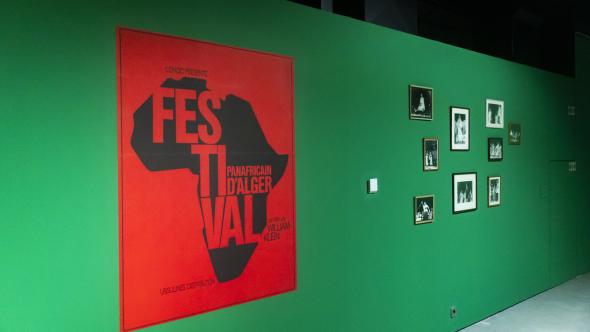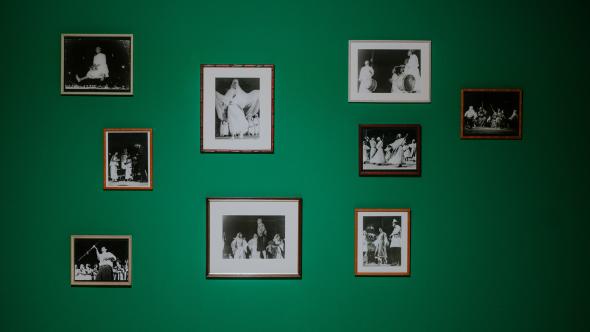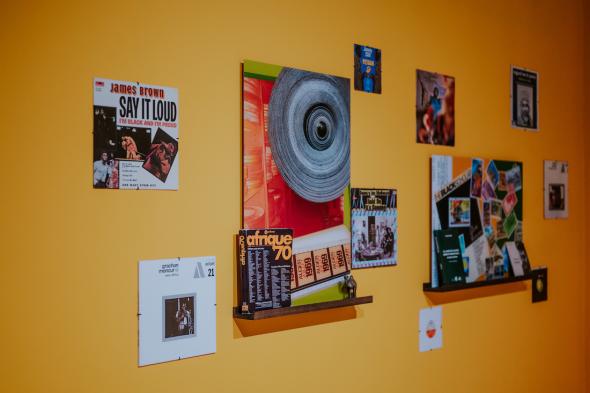Zineb Sedira: Standing Here Wondering Which Way To Go
Algiers, 1969. Seven years after the country’s violent struggle for independence, at a time when Algerians were trying to grapple with their identities and political structures, the city was nicknamed ‘the Mecca of Revolution’ - a key international meeting point for liberation movements and anticolonial projects. It is this historical context of political exchanges and utopias that inspired Zineb Sedira to develop Standing Here Wondering Which Way To Go, a multimedia project that delves into emancipatory dreams, transnational networks and conviviality. Borrowing its title from a song performed by African-American singer Marion Williams at the Pan African Festival of Algiers, the exhibition pays homage to the spirit of solidarity and resistance of the global 1960s which was so present in newly independent Algeria. Divided into four ‘scenes’, the project also celebrates culture in its diverse forms as a vital tool for social mobilisation and political consciousness. From a career perspective, the exhibition expands and reinforces Sedira’s remarkable work around the archive, conceiving it as a space of movement, action and interaction where autobiographical, documentary and historical narratives are juxtaposed.


At Gulbenkian’s Centro de Arte Moderna (CAM) Project Space, Standing Here Wondering Which Way To Go opens up with mise-en-scène, a short video made with old film strips acquired by Sedira from a retired projectionist in Algeria. The artwork’s title, a nod to notions of presentation and performance, invites audiences to question why these decayed images are being given a platform whilst also placing a sharp focus on their materiality. Shown at the Cinemathèque d’Algiers in the 1960s, 70s and 80s, these cinematic fragments now have highly saturated colours, grainy textures and bewildering gaps. Their montage in mise-en-scène can perhaps be considered Sedira’s attempt at making the most of an imperfect past in a challenging present. Faced with deteriorating footage that stands for the neglect and disregard of governments and markets, as well as the fragility around narratives of liberation that infused the post-independence period in Algeria, the artist collates images that navigate between the fractured and the abstract, between what was lost and what can be imagined. With a joyful soundtrack that helps us embrace the vulnerability of the past, mise-en-scène reenchants images of hope and opens up space for thinking activism through notions of care, repair and incompleteness.
Following a narrow corridor, the exhibition leads to the second scene: For a Brief Moment the World Was on Fire…, a selection of images that commemorates the liveliness of the immediate postcolonial period in Algeria. In this scene, the Pan African Festival of Algiers in 1969 takes central stage, and its multidisciplinarity is celebrated through the poster of the famous documentary directed by French photographer filmmaker William Klein; a portrait of the Algerian crowd during the festival, also by Klein; and several shots from the performances, taken by an unknown photographer. In the corner, there are also a couple of photographs by British artist Jason Oddy, referencing the buildings comissioned by the Algerian government in the 1960s to Brazilian architect Oscar Niemeyer. Sedira’s choices of artists and media showcase how the city of Algiers became a true hub for anticolonial networks and action, and how a burgeoning and multifaceted cultural milieu was instrumental for this process.
It is important to highlight that the installation also responds to the Portuguese historical context by including ‘new’ material in this Lisbon-based version. In this second scene, for example, there are documentary images by Algerian photographer Boubaker Adjali which showcase some behind-the-scenes moments of struggle in yet-to-be-independent Angola and Mozambique in 1970. The same corridor contains a selection of activist books published in the 70s in Portuguese and a FRELIMO poster by British designer Robin Fior. These additions work not only as a reminder of how the writing of History is a process of constant reactivation, reinterpretation, reconstruction and reappropriation, but also - and perhaps mainly - that this exercise must always meaningfully engage with local struggles without losing sight of their global links.
The exhibition continues with its two last scenes: Way of Life, a life-size diorama of Sedira’s living room in London, and We Have Come Back, a selection of photomontages, small objects and vinyl records collected by the artist throughout her life. Highlighting the intersection of the personal and the political, these two works are emblematic of the conviviality and solidarity needed to sustain critical memory and modes of resistance. Visitors are invited to take inspiration from the films, books, records and cultural productions that influenced her artistic trajectory; to take a moment to sit down on her sofa and slowly reflect on what intimate spaces represent to political activism; and to remember the many effervescent ways in which those before us have imagined and practiced different worlds.


This invitation to collective remembrance is particularly evident in the 40-minute video interview shown in a loop on the living room’s television set. Speaking to us is Nadira Laggoune-Aklouche, a renowned Algerian curator, art critic and researcher who skilfully intertwines her own memories and experiences of the PANAF with a contemporary analysis of politics and culture. Edited into bite-sized segments that explore the trajectory of Algerian cinema, the effects of anticolonial optimism, the role of education in today’s political scenarios, and the multiple expressions of imaterial heritages, to name just a few themes, Laggoune-Aklouche’s testimony builds a beautiful bridge between experiences of everyday life and the complexity of memory work. With this video, Sedira subverts the centrality of mediated discourses to show that at the heart of her home and artistic practice are informal knowledges and unnoficial narratives.
The video is meant to be watched with headphones, since a playlist by Algerian filmmaker and popular culture researcher Nabil Djedouani also reverberates in the living room installation. This builds an invisible connection with the final scene on the other side of the room, where Sedira shares another version of her personal, cultural archive in We Have Come Back. Presented against a striking yellow background, these music-related montages demonstrate the potential of playfulness and creativity in (art) historical research. Here, Sedira’s perspectives and positionalities as archivist and collection keeper are undeniable, but they are not an imposition nor illustrate a lack of rigour. Instead, the references connected by her are dynamic reminders of the power of affect, curiosity, relationality and lived experience, and of the fact that no work of art (or any form of knowledge production, for that matter) ever exists in a vacuum.
Before leaving the exhibition, visitors are invited to take a newspaper with them - a free, accessible memento that echoes the energy of do-it-yourself movements. The publication contains, among other things, a very eloquent interview between the artist and the curator Rita Fabiana that further contextualises the artworks, as well as a list of anticolonial films curated by Olivier Hadouchi, which were shown at the museum during the opening weekend and which expands the project’s pool of references. Invoking notions of ephemerality and truthfulness, the newspaper arguably symbolises the main conceptual takeaways from the exhibition: despite oppression and erasures, modes of resistance and hope are never truly lost - but it is up to us, all together, to preserve them through transmission, and to consolidate them as valid options in the present.
Standing Here Wondering Which Way To Go is on show at the Gulbenkian Centro de Arte Moderna (CAM) in Lisbon until 19 Jan 2026. 10am-6pm; Saturdays 10am-9pm; closed on Tuesdays. Free entry.
View of the exhibition ‘Zineb Sedira. Standing Here Wondering Which Way to Go’ © Pedro Jafuno